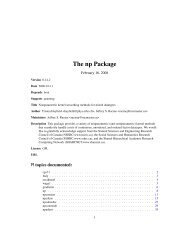The gstat Package - NexTag Supports Open Source Initiatives
The gstat Package - NexTag Supports Open Source Initiatives
The gstat Package - NexTag Supports Open Source Initiatives
You also want an ePaper? Increase the reach of your titles
YUMPU automatically turns print PDFs into web optimized ePapers that Google loves.
sic2004 41Examplesshow.vgms()show.vgms(models = c("Exp", "Mat", "Gau"), nugget = 0.1)# show a set of Matern models with different smoothness:show.vgms(kappa.range = c(.1, .2, .5, 1, 2, 5, 10), max = 10)# show a set of Exponential class models with different shape parameter:show.vgms(kappa.range = c(.05, .1, .2, .5, 1, 1.5, 1.8, 1.9, 2), models = "Exc", max = 10)sic2004Spatial Interpolation Comparison 2004 data set: Natural Ambient RadioactivityDescription<strong>The</strong> text below is copied from http://www.ai-geostats.org/events/sic2004/index.htm, subsection Data.<strong>The</strong> variable used in the SIC 2004 exercise is natural ambient radioactivity measured in Germany.<strong>The</strong> data, provided kindly by the German Federal Office for Radiation Protection (BfS), are gammadose rates reported by means of the national automatic monitoring network (IMIS).In the frame of SIC2004, a rectangular area was used to select 1008 monitoring stations (from a totalof around 2000 stations). For these 1008 stations, 11 days of measurements have been randomlyselected during the last 12 months and the average daily dose rates calculated for each day. Hence,we ended up having 11 data sets.Prior information (sic.train): 10 data sets of 200 points that are identical for what concerns the locationsof the monitoring stations have been prepared. <strong>The</strong>se locations have been randomly selected(see Figure 1). <strong>The</strong>se data sets differ only by their Z values since each set corresponds to 1 dayof measurement made during the last 14 months. No information will be provided on the date ofmeasurement. <strong>The</strong>se 10 data sets (10 days of measurements) can be used as prior information totune the parameters of the mapping algorithms. No other information will be provided about thesesets. Participants are free of course to gather more information about the variable in the literatureand so on.<strong>The</strong> 200 monitoring stations above were randomly taken from a larger set of 1008 stations. <strong>The</strong>remaining 808 monitoring stations have a topology given in sic.pred. Participants to SIC2004 willhave to estimate the values of the variable taken at these 808 locations.<strong>The</strong> SIC2004 data (sic.val, variable dayx): <strong>The</strong> exercise consists in using 200 measurements madeon a 11th day (THE data of the exercise) to estimate the values observed at the remaining 808 locations(hence the question marks as symbols in the maps shown in Figure 3). <strong>The</strong>se measurementswill be provided only during two weeks (15th of September until 1st of October 2004) on a webpage restricted to the participants. <strong>The</strong> true values observed at these 808 locations will be releasedonly at the end of the exercise to allow participants to write their manuscripts (sic.test, variablesdayx and joker).In addition, a joker data set was released (sic.val, variable joker), which contains an anomaly. <strong>The</strong>anomaly was generated by a simulation model, and does not represent measured levels.
















